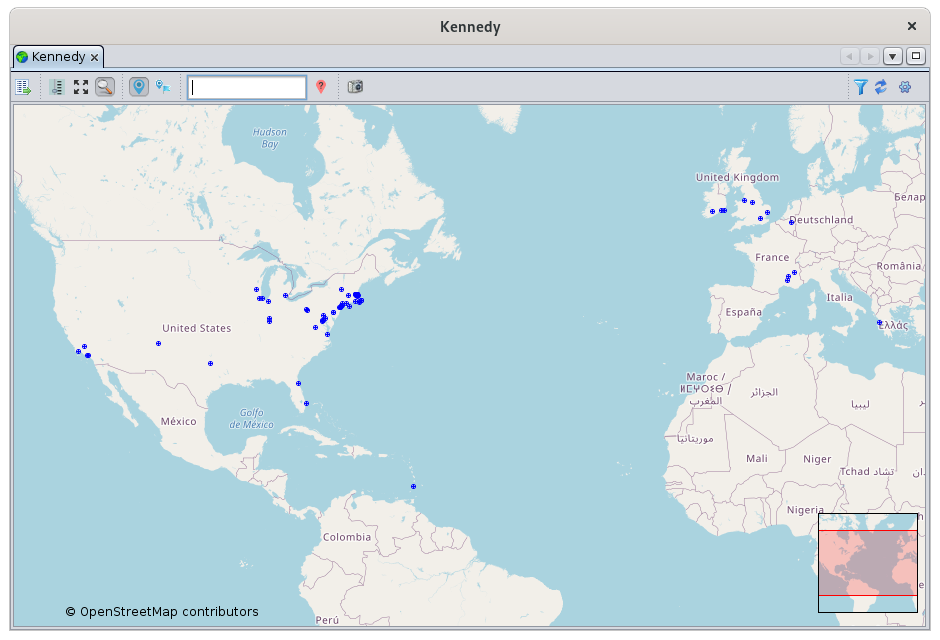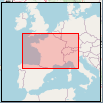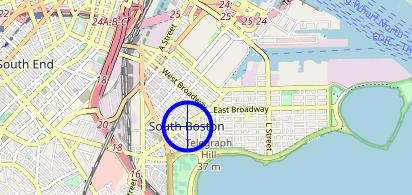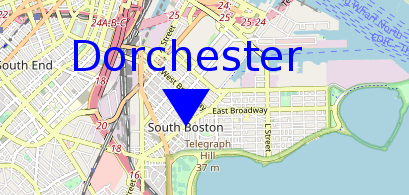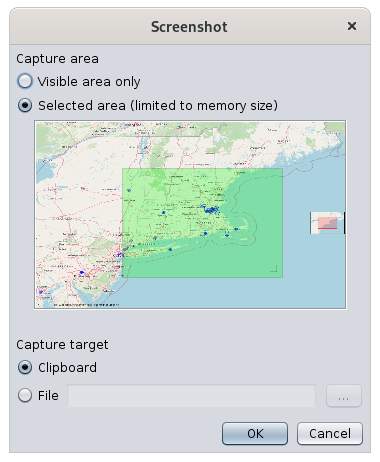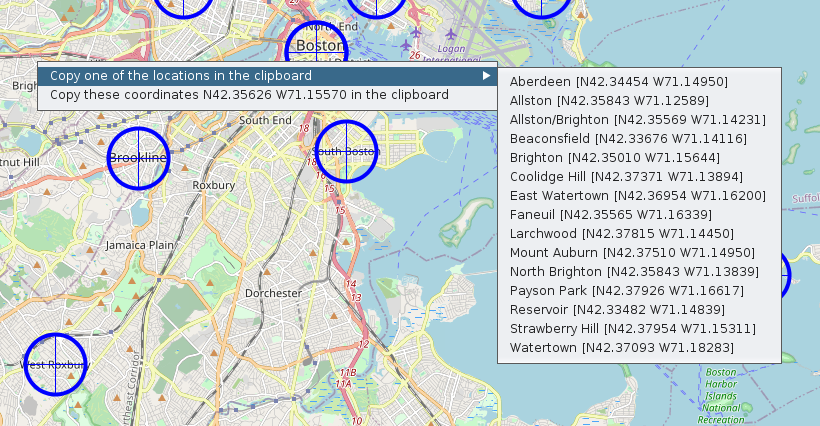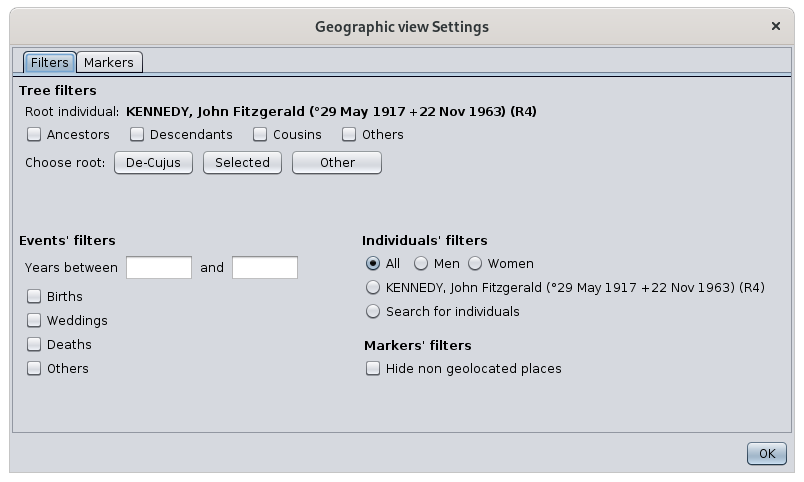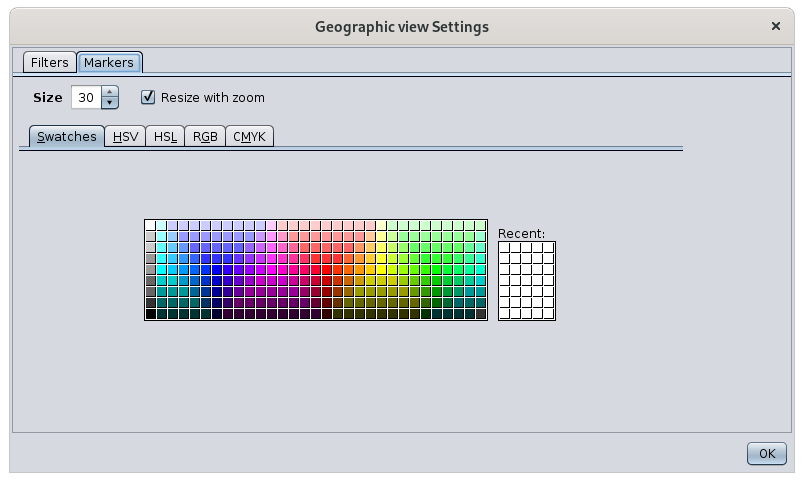Geographic map
The Geographic Mapmap is a view of Ancestris displayingdisplays all the genealogy events at their location on a map.
You can visualize where the events you are interested in have takentook place. In particular, you can apply filters to see only certain events and thus make geographical analyses of the genealogyyour population.
Description
The Map
The Geographic Mapmap is inan OpenStreetMap over which Ancestris plots the formevents. of a map whereThe blue dots represent places where the events of your genealogy took place.
Up close, a marker is a circle with a cross in the center. From a distance, it can be reduced to a point.
Two visual tools appear on the map:
- the zoom
rulerslider at the bottom left with buttons
- the mini location map at the bottom right. The red frame represents the visible part in relation to a larger area of the main map.
Toolbar
A toolbar at the top allows you to modify the display and apply filters.
Display Placesthe Listlist of places Button
This button is a shortcut to activateopens the Place List viewof directly.places view.
Show/Hide Zoomzoom Button
This button shows or hides the zoom slider.slider.
Display the map background and zoom out button to showShow all markers Button
This button adjusts the zoom level and refocusescenters the map so that you can see all the genealogy markers.
Show/Hide Previewoverview Button
This button shows or hides the mini card.
Show/Hide Markersmarkers Button
This button shows or hides the markers.
ChangeToggle Markersmarkers Button
This button toggles between two marker display modes.
Marker in the form of a circle with the cross :
Marker in the form of a label with athe city labelname :
FilterPlace onfilter a placefield
This input field is a quick location filter. It allows you to display only those markers whose location includes the entered string.
To use it, type characters and then press the Enter key to causeapply the filter.
Clear the characters and press Enter again to remove this filter.
Show/Hide non-geolocated places Button
A non-geolocated place is a place with no known geographic coordinates.
It is placed by default off the coast of Bordeaux in the Atlantic Ocean.
In order to alert the user that places cannot be located, and rather than placing them on land, which would not distinguish them from well-located places, we chose to place them in water!the sea!
Screenshot buttonButton
A screenshot window appears allowing you to choose a green area to capture, and to keep the image in the clipboard or in a file.
Filter indicator 
This symbol tells you whether a filter is inbeing effectapplied or not.
A filter is inbeing effectapplied when at least one marker is not displayed.
AnHovering overview ofover this filtersymbol indicatesbrings up a tooltip indicating which filter is in effect.
For example, here a filter is in effect to show only the markers for Joseph Kennedy's ascendingancestors' events.
SearchRefresh forplaces placefrom coordinatesthe Internet Button
This button triggers the search for places on the Internet. See the section Searching for contactcoordinates information forof all locations on the Internet for details.
Configure view Button
See the correspondingCustomization paragraphssection for setting filters and customizing markers.below.
The cardGeographic map is used for:to:
Navigate on the map
The Mapmap is moveable and zoomable, and can be moved by dragging the mouse with the mouse button pressed at any point on the map.
To recenter the map, double-click on the location to be placed in the center of the window.
The zoom level iscan be applied
- with the wheel of the mouse,
thisifoneit remains above the map. - by moving the slider cursor with the mouse,
- step by step by clicking on the
 buttons next to the
buttons next to the ruler,slider, - or by clicking on the
rulerslider and using the up and down cursor keys.
Impact of the zoom change on the center of the map :
- When zooming with the scroll wheel, the geographic point under the mouse remains fixed.
- When zooming with the buttons, the center of the map remains fixed.
Identify events in a given location
From a place marked by a marker on the map, it is possible to identify the events that took place there.
To do this, simply hover over the marker with the mouse. A small blue window appears like this one:
If several locations are very close, this window contains a vertical scroll bar on the left. By activating this scroll bar you can scroll through each of the locations concerned byin the location.area.
This window displays two buttons at the top followed by the full name of the place and the information about the place :
The window then displays the events that occurred there, a bit like a flash report :
- The number of individuals
concernedinbyrelation to this place in your genealogy - The most frequent
patronymiclastnamesonin this place, and the number of times it is mentioned. - The number of events that
have takentook placein this place,there, detailed below by type of event: births, marriages, deaths and others. - The period in years covered by these events.
Update locationsplaces
It is possible to update the premisesplaces in two complementary ways:
- By right-clicking on a point on the map, to identify surrounding locations or to capture the exact coordinates of a location using a location pop-up menu.
- By editing the place, using the place editor that opens from the blue window button described above.
LocationPlace pop-up menu
Two actions appear:
- Copy one of the
surrounding placeslocations to the clipboard:this allowsyoutocan retrieve one of the places from the list in order to use itwhen entering a placelater. - Copy the coordinates XXXXX YYYYY
into the clipboard: thisallows you to retrieveretrieves the exact coordinates of the place to use itlaterlater.for a place. You will be able to paste them on another place in the Place Editor.
Place Editor
From the Edit this place button in the blue window above, you can edit a place.
See the EditPlace Location sectionEditor for more details.
Event Filters
One of the main interests of the map is to be able to apply filters to identify and analyze possible geographical relationships between individuals.
To apply filters, go to CurrentConfigure View Settings. This window appears:
There are 4 groups of filters :
- Filters on the relationship of ascendancy or descent
withinana reference to a root individualDe Cujuswhich is defined only forthethis occasion.- The checkboxes allow you to apply the filters. The corresponding groups of individuals
arewilladdedbe included in the displayed markers - Three buttons allow you to change the
De Cujusroot individual directly if the current one doesn't suit you- Its name is displayed above the check marks
- No numbering or data changes result from this choice of root individual
De Cujus
- The checkboxes allow you to apply the filters. The corresponding groups of individuals
- Filters by type of event and by date of the event.
TheThis will display all events that correspond to the checkboxesareandaddedthattofiteach other but cross withwithin the period entered if any.
- Filters on individuals.
Gender:Gender: only displays the event locations of individuals of the specified gender.- Name of selected
individual:individual: displays only thelocationsplaces of the events of the selected individual whose name is displayed - Search for
individuals:individuals: displays only places with events of individuals from the advanced search
- Filter on the spot.
- Simple filter on non-geolocated locations
Any action on a filter in this window immediately updates the map.
Filters from different groups are combined with each other so that theythe "intersect"displayed withmarkers eachwill other.have to match all conditions.
The use of filters is particularly interesting. It allows for example to answer the question: where are all the bottomspeople of my genealogy?genealogy whose occupation is a baker ?
To do this, simply search for all individuals with a bootmakerbaker professionoccupation fromin the advancedAdvanced search window. Leaving this window open, go to the geographic filters above and check the "Search for individuals" box. The map will then display only the places that have had an event from a bootmaker.baker. You can also check the "Birth" box to have only the places of birth of the bootmakers.bakers.
Customization
It is possible to change the appearance of the markers :
- Their size
- Automatic adjustment of their size with the zoom level
- Their color
To do this, from the CurrentConfigure View Settings, go to the Markers tab and make your choice of size and color.
By default, the size of the markers adjusts to the zoom level used.
- The closer the map is, the larger the markers are, as they are more easily visible and do not overlap each other.
- The further away the
cardmap is, the more markers there are and the more you need to reduce them in size. On the other hand, since the map gives less detail of the topology of the places, they are also more visible and therefore do not need to be as large.
If you do not want Ancestris to change the size of the markers, uncheck the "Resize to fit zoom" box.

